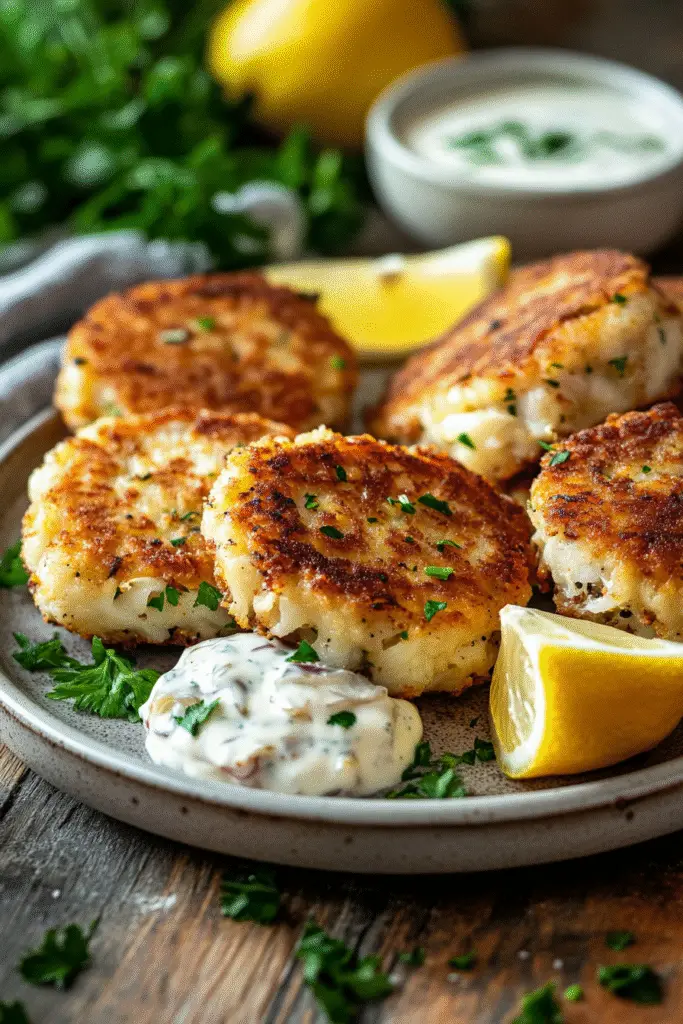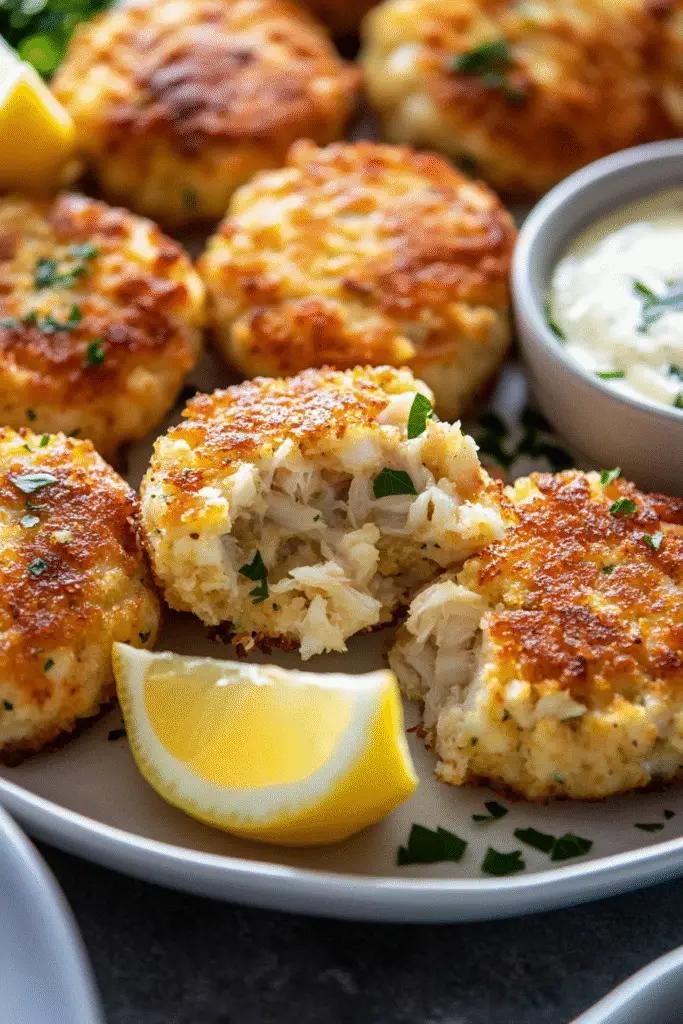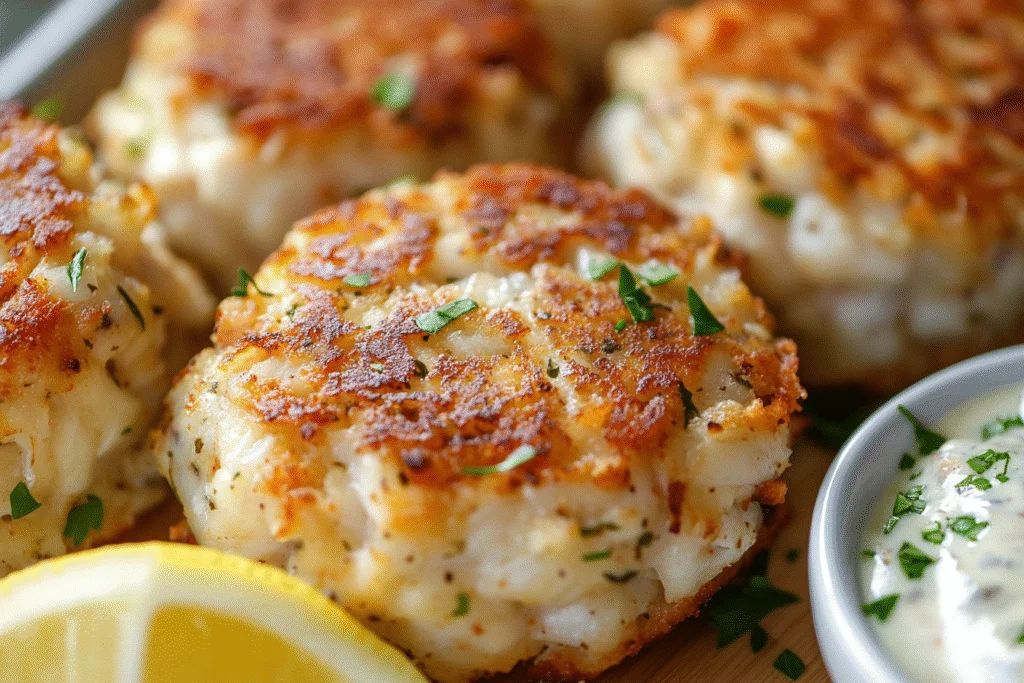Maryland Crab Cakes are a beloved East Coast delicacy, celebrated for their sweet, succulent crab flavor and minimal filler. Unlike many crab cakes found elsewhere, the Maryland version focuses on showcasing the crab itself, not the breadcrumbs or heavy binders. These crab cakes are typically broiled or pan-fried to achieve a lightly crisp exterior while preserving the soft, flavorful interior packed with lump crab meat.
Perfect for summer gatherings, coastal-inspired dinners, or even elevated appetizers, Maryland Crab Cakes are easy to make at home if you know the essential techniques. In this comprehensive guide, we’ll explore every step—from selecting the right crab meat to binding the cakes without overpowering the crab, achieving the perfect sear, and avoiding common mistakes like falling apart or becoming dry.
Why Maryland Crab Cakes Work: Sweet, Minimal, and Perfectly Balanced
The magic of a Maryland Crab Cake is simplicity.
These cakes are all about letting the crab shine.
Core Components:
- Jumbo lump crab meat: Sweet, tender, and the undisputed star of the dish.
- Minimal binder: Just enough to hold the cake together without overwhelming the crab.
- Old Bay seasoning: A Maryland classic that adds subtle spice without masking the crab’s flavor.
- Light crispness outside, tender inside: Achieved through careful handling and quick broiling or pan-frying.
When made properly, Maryland Crab Cakes are delicate, moist, and bursting with crab flavor—not breading.
Choosing the Right Crab Meat: Freshness Is Key
Best Crab Meat for Authentic Maryland Crab Cakes:
- Jumbo lump crab meat: The gold standard. Large, sweet, tender pieces.
- Backfin crab meat: More affordable, slightly smaller flakes, still sweet.
- Avoid: Imitation crab, claw meat (too strong), or over-processed canned crab.

Where to Buy:
- Seafood markets, trusted grocery seafood sections, or quality canned refrigerated crab (typically in a can marked “jumbo lump” in the refrigerated section).
Pro Tip:
Always pick through crab meat gently with your fingers to check for stray shell fragments.
Binding Without Overpowering: Less Is More
Maryland Crab Cakes use just enough binder to hold together without losing the delicate texture.
Essential Binding Ingredients:
- Mayonnaise: Provides creaminess and moisture.
- Egg: Helps bind the mixture without making it dense.
- Minimal breadcrumbs or crushed crackers: Just enough to stabilize, not to dominate.
Seasoning Must-Haves:
- Old Bay seasoning: Signature Maryland spice blend.
- Dijon mustard and Worcestershire sauce: Add savory depth.
- Lemon juice: Brings brightness.

Recommended Equipment
- Mixing bowl: For gently combining ingredients.
- Sheet pan: For broiling or baking.
- Skillet (optional): For pan-frying crab cakes.
- Fish spatula: Ideal for gently flipping delicate cakes.
- Wire rack (optional): Helps keep baked crab cakes crisp.
Common Mistakes and How to Avoid Them
1. Falling Apart
- Happens if not enough binder is used or crab cakes are over-handled.
- Solution: Chill cakes before cooking to help them firm up.
2. Too Bready
- Caused by using too much filler.
- Solution: Use just enough crumbs or crackers to hold together.
3. Dry Texture
- Happens if overcooked.
- Solution: Broil or pan-fry just until golden and heated through.
4. Overpowering Seasoning
- Using too much Old Bay can overwhelm the sweet crab.
- Solution: Season lightly and let the crab shine.

Preparation and Meal Planning Tips
Make-Ahead Friendly:
- Form crab cakes and refrigerate for up to 24 hours before cooking.
- Crab cakes can be frozen raw or cooked for future meals.
Serving Suggestions:
- Classic accompaniments include lemon wedges, tartar sauce, or a simple remoulade.
- Serve with coleslaw, roasted potatoes, or a fresh green salad.
Flavor Variations and Customizations
Cooking Methods:
- Broiled: Traditional, gives a lightly browned exterior.
- Pan-fried: Richer flavor with a golden crust.
- Baked: Lighter option, especially if paired with a crisping technique like a wire rack.
Topping Ideas:
- Drizzle with remoulade, lemon aioli, or spicy sriracha mayo.
Protein Variations:
- Maryland crab cakes are traditionally all about crab, but salmon cakes follow similar methods if crab isn’t available.
Ingredient List
For the Crab Cakes:
- 1 pound (450 g) jumbo lump crab meat, gently picked over for shells
- ¼ cup (60 g) mayonnaise
- 1 large egg
- 1 teaspoon Dijon mustard
- 1 teaspoon Worcestershire sauce
- 1 teaspoon Old Bay seasoning
- 1 tablespoon lemon juice
- ¼ cup (15 g) breadcrumbs or crushed saltine crackers
- 2 tablespoons fresh parsley, chopped (optional)
- Salt and pepper to taste
- 2 tablespoons unsalted butter or oil (if pan-frying)
For Serving:
- Lemon wedges
- Tartar sauce, remoulade, or lemon aioli
Step-By-Step Instructions
1. Prepare the Crab Mixture
In a large bowl, gently whisk together mayonnaise, egg, Dijon mustard, Worcestershire sauce, Old Bay seasoning, lemon juice, and a pinch of salt and pepper.
Fold in crab meat and breadcrumbs carefully with a spatula or your hands. Avoid breaking up the crab lumps.
Mix just until combined; the mixture should be moist but hold together.
2. Form and Chill
Shape the mixture into 6–8 patties, about ¾ to 1 inch thick.
Place on a plate or baking sheet and refrigerate for at least 30 minutes (up to 24 hours) to help them set.
3. Cook the Crab Cakes
Broil Method:
Preheat the broiler.
Place crab cakes on a greased or parchment-lined baking sheet.
Broil for 8–10 minutes, flipping halfway through, until golden brown.
Pan-Fry Method:
Heat butter or oil in a large skillet over medium heat.
Cook crab cakes for 3–4 minutes per side until golden and warmed through.
4. Serve
Serve hot with lemon wedges and your choice of tartar sauce, remoulade, or a simple lemon aioli.
Pair with a fresh salad, roasted potatoes, or steamed vegetables.
Troubleshooting and FAQs
Can I freeze Maryland crab cakes?
Yes. Freeze uncooked crab cakes on a baking sheet, then transfer to freezer bags. Thaw in the fridge before cooking.
What if my crab cakes fall apart while cooking?
They may need more chilling time or slightly more breadcrumbs. Always handle gently.
Can I use canned crab meat?
Refrigerated, high-quality canned lump crab meat works, but avoid shelf-stable imitation crab.
Can I bake crab cakes instead?
Yes. Bake at 400°F (200°C) for 12–15 minutes until golden, flipping once.
Variations: Classic, Light, and Spicy Versions
| Version | Crab Type | Binder | Cooking Method |
|---|---|---|---|
| Classic | Jumbo lump | Minimal crumbs | Broiled |
| Light | Backfin | Reduced mayo | Baked |
| Spicy | Jumbo lump | Add hot sauce | Pan-fried |
Storage and Reheating Tips
- Storage: Refrigerate cooked crab cakes for up to 3 days.
- Reheating: Warm in a 350°F (175°C) oven until heated through (about 10–12 minutes).
- Freezing: Freeze raw or cooked crab cakes for up to 3 months.
Final Thoughts
Maryland Crab Cakes are a perfect example of how simplicity and high-quality ingredients can create an unforgettable dish. The key is minimal filler, gentle handling, and focusing on the sweet, tender crab meat.
Whether you serve them broiled, pan-fried, or baked, these crab cakes are a versatile main course or appetizer that brings a taste of the Chesapeake Bay right to your kitchen. I hope this guide helps you master Maryland Crab Cakes at home—feel free to experiment with spice levels, sauces, and serving styles to make them your own!
